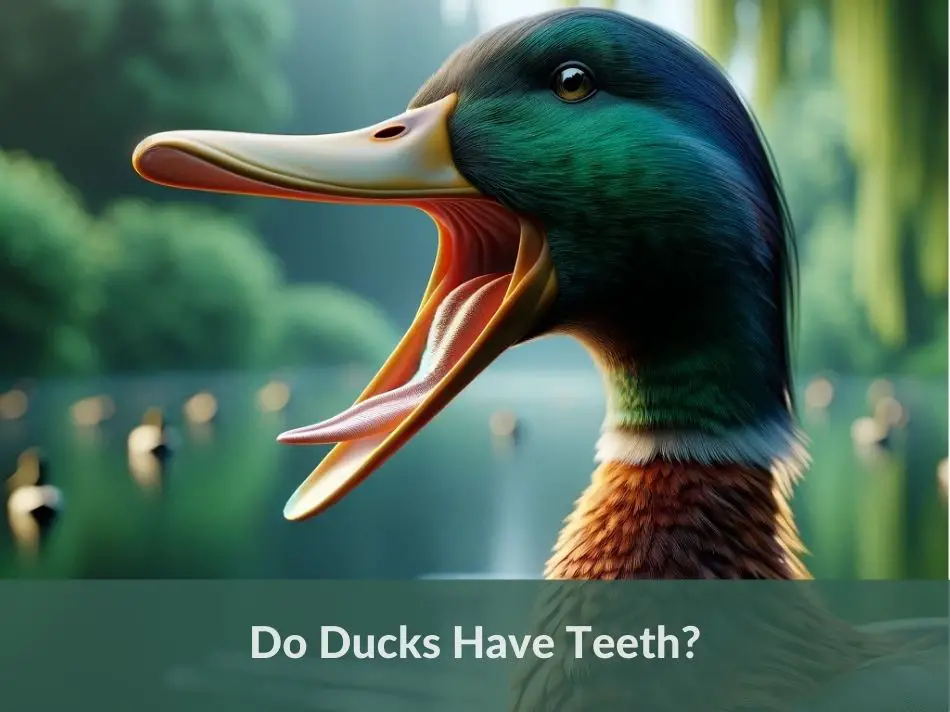Ducks, with their serene presence on water bodies across the globe, have long fascinated observers. One of the most intriguing aspects of these feather ed creatures is their anatomy, leading to various myths and misconceptions. A common query that arises is about the existence of teeth in ducks.
The surprising answer is no, ducks don’t have teeth. It’s because they don’t have to chew their food. Their food is often small with no need to chew it and some species can even filter the things they eat.
This article aims to demystify this topic, offering insight into the unique anatomical features of ducks, especially focusing on their bills and feeding habits. Understanding these aspects not only enhances our knowledge but also fosters a deeper appreciation for these ubiquitous yet often misunderstood birds.
Do Ducks Have Teeth?
The belief that ducks have teeth is a misconception. In reality, ducks lack teeth entirely. What may appear to be teeth are actually serrated edges along their bills, resembling a saw-like structure. These serrations are made of keratin, the same material as human fingernails, and are far from the hard, enamel-coated teeth found in mammals.
The primary function of these serrated bills is to aid in feeding – they help ducks grip slippery food like fish and amphibians. It’s a classic example of evolutionary adaptation, where ducks have developed a specialized tool in their bills that mimics the function of teeth without actually having them.
This adaptation allows ducks to efficiently forage and feed in their aquatic environments, showcasing the diversity and ingenuity of nature’s designs.
Can Ducks Chew Their Food?
Lacking teeth, ducks are incapable of chewing. Their feeding process is quite different from animals that chew their food. Ducks use their bills to grasp and scoop up food, which is then swallowed whole. This ingestion process bypasses the need for chewing.
Once swallowed, the food enters the duck’s digestive system, where it first reaches the gizzard. The gizzard, a muscular part of the stomach, contains small stones that the duck has swallowed. These stones grind the food, effectively ‘chewing’ it within the gizzard.
This process allows ducks to digest a variety of foods, from aquatic plants to small fish, making up for the lack of teeth. This unique digestive adaptation is a testament to the evolutionary efficiency of ducks, enabling them to thrive in diverse habitats.
Anatomy of Duck Bills
The duck’s bill is a complex and versatile tool, perfectly evolved for its lifestyle. Comprising several key components, each part plays a vital role in the duck’s survival. One of the most notable features is the lamellae – fine, comb-like structures along the edges of the bill.
These lamellae help ducks filter food from water, trapping smaller particles and organisms. The bill’s shape is also significant. Most ducks have a spatulate-shaped bill, wide and flat, ideal for sifting through mud and water. This shape allows ducks to dabble and forage effectively in various environments.
Additionally, the nail at the tip of the upper bill serves as a useful tool for digging into substrates and probing for food. Another interesting feature found in some species is the grin patch, a spot where the upper and lower bill converge.
It plays a role in the duck’s feeding strategy and is easily noticeable in certain species. Collectively, these features highlight the specialized nature of the duck’s bill, a prime example of evolutionary adaptation to environmental demands.
Duck FAQ’s
Ducks eat without teeth by using their beaks to scoop or filter food, often from water. They rely on their tongue and beak to manipulate and swallow food directly.
Lamellae are thin, comb-like structures on the inside edge of a duck’s beak. They act as filters, allowing ducks to sieve small particles like insects and plants from water.
Ducks process food without teeth by swallowing it whole. The food then goes to their gizzard, a muscular part of the stomach, where it is ground up with the help of grit and small stones that ducks ingest.
Yes, ducks swallow food whole. They lack teeth to chew, so their gizzard helps break down the food after swallowing.
Final Thoughts
The fascinating world of ducks, with their unique adaptations and behaviors, offers a window into the complexity of avian life. Their distinct bill anatomy, serving the purpose of teeth, demonstrates nature’s ingenuity. Understanding that ducks do not have teeth, but rather specialized bills, enhances our appreciation of these animals.
Ducks, thriving in their natural habitats with varied diets, remind us of the richness of wildlife. Observing and respecting ducks in their environments is crucial for their preservation and our continued enjoyment of their


